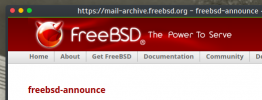… not inline with, and even clashes with, the FreeBSD website, …
… FreeBSD website information inline with the Handbook, …
… From the above Handbook quote: … contradiction with: …
… If you or Colin Percival feel that FreeBSD-STABLE should be designated otherwise, I strongly suggest: change all documentation accordingly. …
… FreeBSD Support Model. …
Re: clashes and contradictions in documentation and elsewhere, please see:
<link removed>
Last edited:


